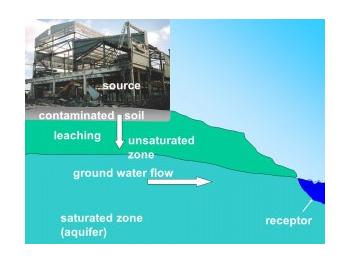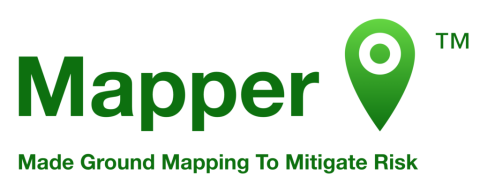CPD
CONTAMINATED LAND; and avoiding unpleasant surprise
Aim:
To provide a broad understanding of contaminated land issues as they affect industry professionals and their clients.
Content:
The current legislative framework and its philosophy. Roles and responsibilities in land clean up. Implications of land transfer.
A brief description of the CLEA and ConSim methodologies for dealing with contamination of soil and controlled waters respectively.
Location: Your Office
Time: To suit you, typically at lunch time. With questions the presentation fits within a lunch hour.
Please contact Peter George to arrange a presentation

Flow Chart
In this we have presented in flow chart form the four stage process of discharging contaminated land planning conditions, from desktop study, to investigation, remediation strategy through to verification of clean up.
Our Brochure
Please find our brochure below for an introduction to our team and the services we offer.
Phase 1 Reports: The What and Why Explained
View our video for an introduction to phase 1 reports, why they are required and how they help to ensure that the follow on phases are looking for the right things in the right places in the most cost effective way.
Planning Condition Discharge Schedule Example
For your project we can produce a schedule setting out which reports you need to discharge each planning condition and monitor progress to assist in timely project delivery.
Made Ground Mapper
We all know and have heard it said many times that the biggest risk is in the ground. To help our clients we have developed the

Vapour Monitoring
Cannot or do not want to get a drilling rig into your basement or other difficult to access area? We can install and monitor using the minimally disruptive Vapor Pin®.
Frequently Asked Questions
What does "site investigation" mean?
The process of learning more about a site's chemical and physical characteristics is known as site investigation. This information is used to assess the site's suitability for various purposes, including construction, land development, and environmental protection. Site investigation typically includes activities such as soil sampling, groundwater monitoring, ground gas and vapour monitoring and geophysical surveys.
What are the benefits of site investigation?
Site investigation can provide many benefits, including the identification of potential hazards, the assessment of risk, and the development of remediation plans. Site investigation can also help to protect human health and the environment by identifying and addressing contamination issues before they become problems. Starting on-site without a thorough investigation is like crossing the road without looking.
What is a site condition report?
Site Condition Reports (SCRs) are required for facilities falling within the scope of the Environmental Permitting Regulations where the Environment Agency considers there may be a significant risk to land or groundwater. This applies to new permit applications, variations and during the transfer or surrender of permits.
The SCR details the condition of land and groundwater at the time of the report. The purpose of this report is to demonstrate that you have protected land and groundwater during the lifetime of the site and that it is in a satisfactory state when the permit is surrendered.
What environmental reports are required for planning?
Initially, a desktop study with a site visit will be required to identify the level of potential risk. If the risk is assessed as low, no further action may be required. If the risk is considered to be significant, then it is necessary to undertake an intrusive investigation.
Generally, a phase 2 Scope of Works or plan will be prepared setting out the extent of investigation that is to be undertaken.
The phase 2 intrusive investigation will be targeted at those risks identified in the desktop study, soil, groundwater, ground gas or vapours or a combination of these. If contamination is found at levels that present an unacceptable risk it is necessary to move on the stage three.
A phase 3 remediation strategy sets out in detail what needs to be done to ensure there will be no elevated risk to potential receptors due to the proposed site use.
Once remediation has been completed it will be necessary to prepare a verification report which provides confirmation that the remediation has been fully and correctly completed.
You can download our flow chart which illustrates this process.
What is site-specific conceptual model?
It is a simplified representation of how the real system is believed to behave based on a qualitative analysis of field data. The data assessed includes current and historical potentially contaminating activities on or near the site, the underlying geology, aquifers, surface water and potential receptors, e.g. site users and the environment. A quantitative conceptual model includes preliminary calculations for key processes.
A site-specific conceptual model forms the framework for producing a risk assessment.
What is risk assessment?
The practice of evaluating the potential dangers connected to a particular activity or location is known as risk assessment. To detect and evaluate the risks posed by pollutants, hazardous compounds, and other possible hazards, risk assessments are utilised. Potential sources of contamination are identified and potential receptors, which might be site users, an aquifer or neighbours: Possible links between these are then assessed. Then the hazard severity is noted, the likelihood of occurrence and from these a risk or significance is judged enabling implementation of appropriate mitigation or design of the further investigation. To guarantee that the right safeguards are taken to protect both human health and the environment, risk assessments are a crucial component of site investigations.
What are some common contaminants found at contaminated sites?
Common contaminants found at contaminated sites include asbestos, arsenic, lead, e.tc.. Asbestos is a naturally occurring mineral that has been used in a multiplicity of items. Heavy metal lead was once utilised in plumbing supplies and paint.
What is contaminated land?
This depends on why you are asking the question.
Firstly contamination can be natural, in the UK, most commonly high levels of arsenic and also radon gas. Radon is a colourless, odourless radioactive gas. It is formed by the radioactive decay of the small amounts of uranium that occur naturally in all rocks and soils.
As pretty much the whole of the UK has been subject to some form of human activity, there are contaminants due to this to be found almost everywhere.
Under Part 2A Contaminated Land Statutory Guidance, land is legally defined as ‘contaminated land’ where substances are causing or could cause:
- significant harm to people, property or protected species
- significant pollution of surface waters (for example lakes and rivers) or groundwater
- harm to people as a result of radioactivity
Under planning the onus is reversed; rather than proving it is a risk as under part 2A, it is necessary to prove the land is safe to use.
What are some common methods of remediation?
Common methods of remediation include soil removal and groundwater treatment. Soil removal involves excavating contaminated soil and transporting it to a landfill. Groundwater treatment involves pump-and-treat or in situ technologies.
What are some common health effects of exposure to hazardous substances?
A number of health issues, including as cancer, birth defects, respiratory issues, skin irritation, and gastrointestinal problems, can be brought on by exposure to dangerous substances. Additionally, some dangerous chemicals can harm the brain system, liver, and kidneys. Children who are exposed to lead may have learning difficulties and behavioural issues. Exposure to mercury can cause neurological problems. Exposure to PCBs has been linked to cancer. VOC exposure may result in headaches, nausea, and drowsiness. Exposure to petroleum products can cause skin irritation and gastrointestinal problems.
GO Contaminated Land Solutions - Why Us?
Concerned about how your construction project will affect the environment?
GO Contaminated Land Solutions has the experience and knowledge to help you with any environmental issue. We have a team of experts that can assist you with Phase 1 Environmental Reports, Desktop Studies, Preparation of Phase 2 Investigations, Developing Remediation Strategies, Monitoring site remediation, and Completion of Verification Reports.
We also offer qualitative flood risk assessments in London and the South East. This service is essential for those who are interested in learning about the potential risks associated with flooding. Our analyses are customised to your particular requirements and will provide you all the knowledge you need to make wise decisions regarding your home or company.
Our clients include Surveyors, Architects, Project Managers, Developers and Design & Build Contractors. With years of experience in the environmental sector, we provide an objective, independent service.
To learn more about our services, get in touch with us right away!
Glossary of Abbreviations
Please find our glossary of abbreviations list below. Hope you find what you are looking for, if not give us a ring.